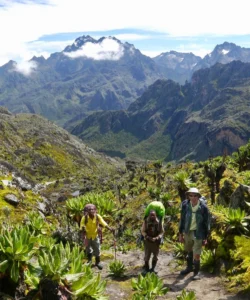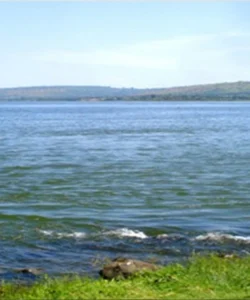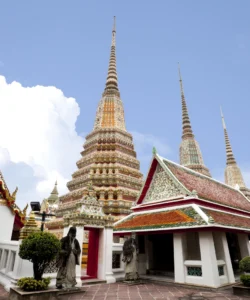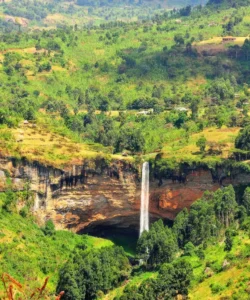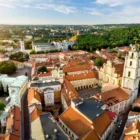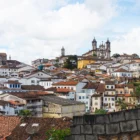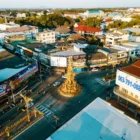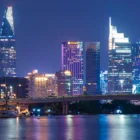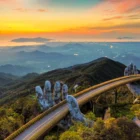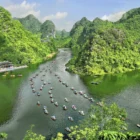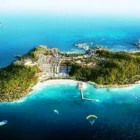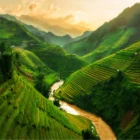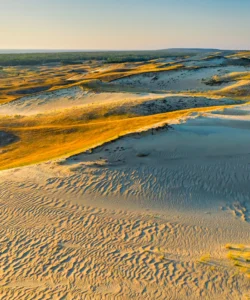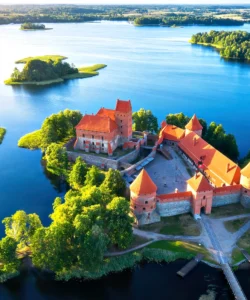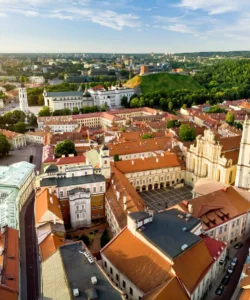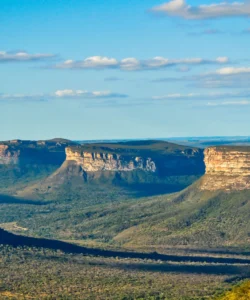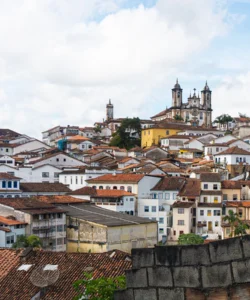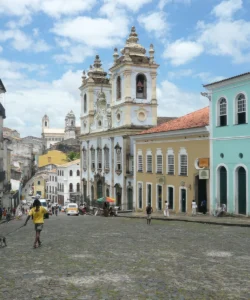The Kazinga Channel is a natural, wide, 32-kilometer (20-mile) long waterway located within Queen Elizabeth National Park in western Uganda. It serves as a vital link between two of Uganda’s largest lakes, Lake Edward and the smaller Lake George, and is renowned for its astonishing concentration of wildlife, particularly hippos and crocodiles. A boat cruise along this channel is considered the highlight of any safari in Queen Elizabeth National Park, offering unparalleled close-up views of diverse fauna and vibrant birdlife against a backdrop of stunning savanna and wetland landscapes.
Name: Kazinga Channel
Address: Queen Elizabeth National Park, Western Uganda, primarily in the Rubirizi District. The main boat cruise departure point is at Mweya Peninsula, near Mweya Safari Lodge.
How to get there:
Reaching the Kazinga Channel means first getting to Queen Elizabeth National Park. This typically involves travel, to Entebbe, Uganda, and then a domestic journey:
- From Entebbe/Kampala (Uganda) to Queen Elizabeth National Park (Mweya/Kazinga Channel):
- By Road (Common Safari Option): The park is approximately 370-420 km (230-260 miles) west of Kampala. The drive takes around 5-8 hours, depending on the route and road conditions. Safari operators typically arrange pickup from Entebbe/Kampala in a sturdy 4×4 safari vehicle. You can approach via Mbarara or Fort Portal.
- By Air (Faster Option): Daily domestic flights depart from Entebbe International Airport or Kajjansi Airfield (near Kampala) to Mweya Airstrip, which is very close to the Kazinga Channel boat departure point. Flights generally take 1-2 hours.
- To the Boat Cruise Starting Point: The most popular boat cruises depart from the dock beneath Mweya Safari Lodge on the Mweya Peninsula, located in the northern part of Queen Elizabeth National Park.
Best Time to Visit:
The Kazinga Channel boat cruise is excellent year-round. However, the dry seasons (January to February and June to September) are generally considered optimal for wildlife viewing. During these periods, vegetation is less dense on the shores, and animals tend to congregate closer to the channel for water, making them easier to spot. The clear skies also make for better photography.
Operating Hours and Entrance Fee:
- There is no separate “entrance fee” for the Kazinga Channel itself beyond the general Queen Elizabeth National Park entry fee (US$40 per foreign non-resident adult per day).
- Boat Cruise Fees: Typically, a scheduled 2-3 hour boat cruise costs around US$30-32 per person. Cruises usually run at set times, for example, 11:00 AM, 2:00 PM, and 4:15 PM. Private boat cruises can also be arranged.
- Note: Fees are subject to change by the Uganda Wildlife Authority (UWA). It’s always best to check the latest rates and book boat cruises in advance, especially during peak season.
Landscape and Architecture:
The Kazinga Channel’s “architecture” is primarily its vibrant natural ecosystem, shaped by the flowing waters and geological features of the Albertine Rift Valley:
- Natural Waterway: The channel is a wide, natural freshwater waterway that smoothly connects Lake George to Lake Edward. Its banks are mostly low-lying, sometimes marshy, providing easy access for animals.
- Vast Water Bodies: The channel is framed by the expansive waters of Lake Edward to the west and the smaller, shallower Lake George to the east, creating a sense of a vast aquatic landscape.
- Lush Riverine Vegetation and Papyrus Swamps: Along its shores, the channel is lined with lush riverine vegetation, thick papyrus swamps, and scattered acacia trees, providing crucial habitats for a diverse range of birds and aquatic life.
- Savanna Plains: The surrounding landscape of Queen Elizabeth National Park, particularly the North Kazinga and Kasenyi Plains, features open savanna grasslands that stretch to the channel’s edge, allowing for excellent visibility of terrestrial wildlife coming to drink.
- Concentration of Wildlife: The true “architecture” is the living, breathing collection of wildlife that congregates at the channel. The shores are teeming with one of the world’s largest concentrations of hippos (estimated over 2,000-3,000 individuals), numerous Nile crocodiles basking in the sun, and large herds of elephants and buffaloes coming to drink, bathe, and graze.
- Birdlife Haven: The channel is a paradise for birdwatchers, with over 600 bird species recorded in the park, many of which are water birds found along the channel, including pelicans, cormorants, kingfishers, eagles, storks, and the elusive African Skimmer.
- Local Fishing Communities: Scattered along the channel and on the shores of the lakes are small, traditional fishing villages, adding a human cultural element to the natural landscape, with their simple huts and fishing boats.
- Mweya Peninsula: This prominent peninsula juts into the channel from the north, offering elevated views and serving as the primary hub for safari lodges and the boat cruise embarkation point.
What makes it famous:
The Kazinga Channel is famous for:
- World’s Highest Concentration of Hippos: It is renowned globally for having one of the largest populations of hippos in the world, with thousands of individuals packed into its waters.
- Exceptional Wildlife Viewing on a Boat Cruise: The 2-3 hour boat cruise is consistently rated as the highlight of a safari in Queen Elizabeth National Park, offering incredibly close-up and safe encounters with a vast array of wildlife, including hippos, crocodiles, elephants, buffaloes, and numerous antelopes, all from a unique water vantage point.
- Birdwatcher’s Paradise: With hundreds of bird species, particularly water birds, it is a prime location for birdwatching, attracting enthusiasts from around the globe.
- Crucial Ecosystem Link: As a natural channel linking two major lakes, it plays a vital ecological role in supporting the rich biodiversity of Queen Elizabeth National Park.
- Photographic Opportunities: The close proximity to wildlife and the stunning natural backdrop provide exceptional opportunities for wildlife photography.
- Complementary to Game Drives: It offers a different perspective of the park’s wildlife compared to land-based game drives, making for a comprehensive safari experience.
Differences from some other wonders:
The Kazinga Channel distinguishes itself from other natural wonders, particularly other wildlife viewing locations or waterways, in several key ways:
- Unparalleled Hippo Density: While other African parks have hippos, the sheer volume and concentration of hippos along the Kazinga Channel are considered one of the highest in the world, making it a unique spectacle. This is its most significant and defining feature.
- Dedicated Boat Safari Experience: While many parks offer some form of water safari, the Kazinga Channel boat cruise is an incredibly well-established, consistently rewarding, and almost mandatory activity within QENP. It’s not just an add-on, but a central component of the park’s safari experience, designed to showcase its unique aquatic and terrestrial wildlife interactions.
- Seamless Integration of Aquatic and Terrestrial Wildlife: The channel acts as a natural magnet, drawing a vast array of terrestrial animals (elephants, buffaloes, antelopes) directly to its shores for water, creating a dynamic and constantly shifting interface between land and water wildlife viewing that is particularly rich.
- Less Affected by Seasonal Water Scarcity (for animals): Unlike some seasonal rivers or waterholes in other parks that might dry up, the Kazinga Channel, as a link between two large lakes, provides a permanent and reliable water source, ensuring animals congregate there consistently, making it a reliable wildlife viewing spot year-round.
- No Land-Based Access for Core Viewing: The most impactful wildlife viewing along the channel is almost exclusively done from the water, from a boat. This water-based perspective is the primary way to experience its wildlife, differentiating it from purely land-based safaris.
- Ecological Service as a “Corridor”: Beyond just being a body of water, its function as a natural corridor connecting two significant lakes makes it an important ecological artery that supports the entire surrounding ecosystem.
In essence, the Kazinga Channel is a powerful and unique wonder, a vital artery of life within Queen Elizabeth National Park that offers an unparalleled and intimate boat safari experience, showcasing one of Africa’s most astonishing concentrations of wildlife, especially its iconic hippos.





















